For those of us brought up in less interesting circumstances, Colin Crabbe’s life is something out of J. K. Rowling and Hollywood. Parents with connections to royalty, castles and ghosts, public schools, the ruins of mediaeval abbeys were all a part of his young life. Colin Crabbe never lost sight of the wonderful past that surrounded him which would eventually drive him to become one of the world’s great car collectors. Below, we have excerpted paragraphs from his autobiography; this segment focuses on his youth, and the next segment will deal with some of the fantastic cars he has found and raced. Edited and published with permissions from the publisher and author. BTW, the publisher is running low on copies, so order now!.
By Colin Crabbe
Photos courtesy Colin Crabbe
John Crabbie, my grandfather, was born in 1861. He became a career soldier in the Scots Greys serving with distinction in the Boer War. My father Archie was the last of John Crabbie’s four children and was born in 1903 at Duncow House in Dumfriesshire. This large and hideous Victorian edifice was built in 1861.
In 1929 Archie met my future French Canadian mother Yvette McKenna, the grand-daughter of Narcisse Pérodeau, an imposing fellow and the 14th Lieutenant Governor of Quebec.
The famous Egyptologist Howard Carter … gave her a tiny gold ring that he had removed from the tomb of Tutankhamun, perhaps with wicked intent towards my mama in mind?
Yvette had been introduced to the Prince of Wales at Government House during his Canadian Tour in 1927, while Yvonne, my grandmother apparently had become a ‘close’ friend of the Prince (or it might have been my mother). There is a fine official photograph of the occasion with Yvonne seated between the Prince of Wales and Prince George, later Duke of Kent.
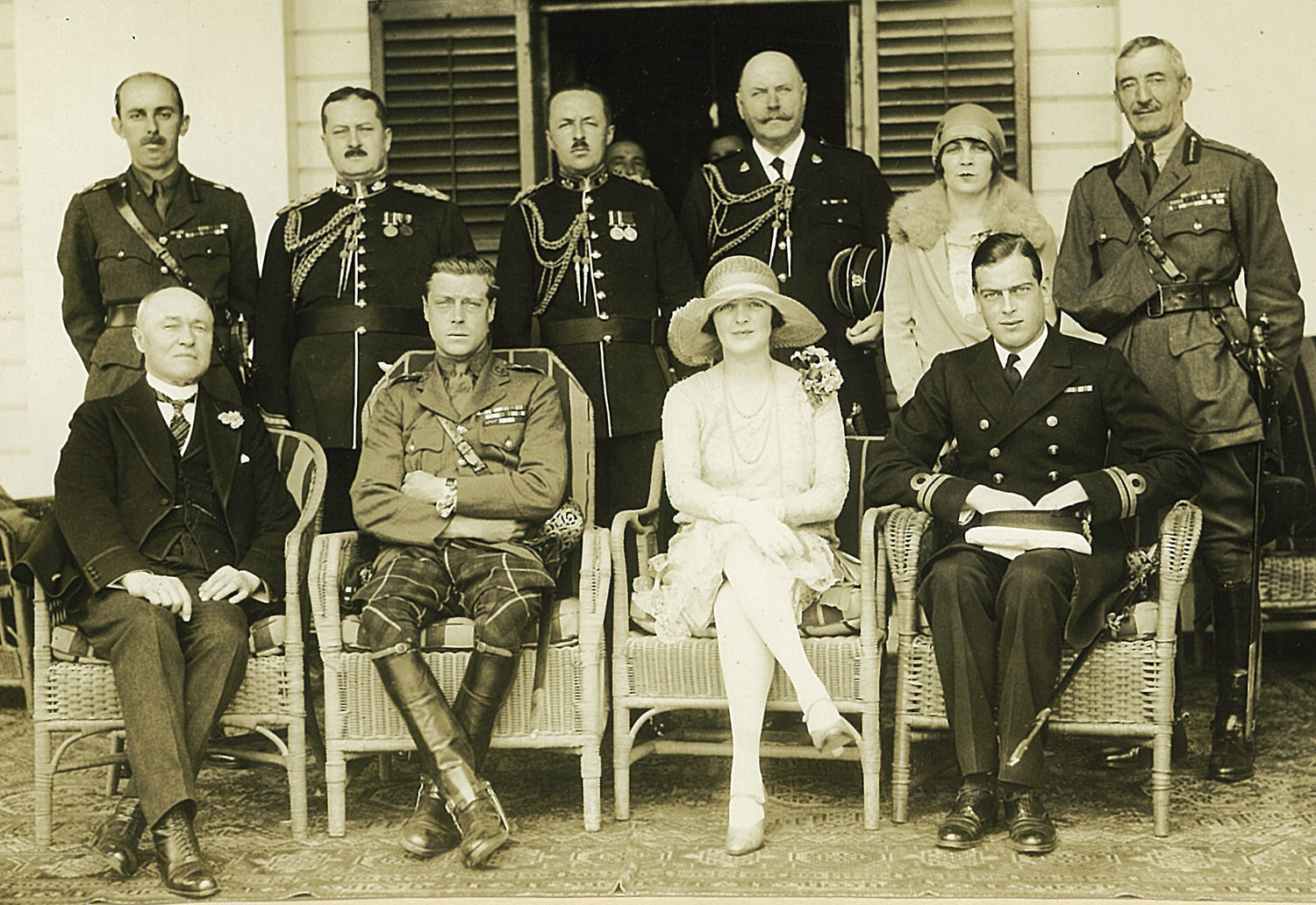
1927 Quebec. My great grandfather front row, left, Prince of Wales, next, my grandmother, then on the right The Duke of Kent.
Yvette was sent on a world cruise under the strict guidance of two elderly spinster aunts and met a hero of mine, the famous Egyptologist Howard Carter on board. He gave her a tiny gold ring that he had quietly removed from the tomb of Tutankhamun, perhaps with wicked intent towards my mama in mind?
Yvette and Archie were married in Quebec on September 3, 1940 [and I was born in 1942]. Archie bought the Findrack Estate in 1944. This was a lovely property overlooking Deeside some twenty-two miles west of Aberdeen. It was a wonderful place for a child to be brought up. The house faced south overlooking the River Dee in the distance and beyond lay the Grampian Hills. Behind the house was a vast flower garden with a high wall on three sides and a fine listed 18th century dovecot in one corner. There was also a magnificent ten foot high beech hedge shielding the garden from the house.
My early upbringing was really a leftover from the Edwardian days. There were two recurring nightmares I used to have, one about human skeletons and the other outer space. Skeletons still worry me and the thoughts of eternity and space together would keep me awake for many a night. A nanny looked after me in my earliest days and she was followed by several governesses who endeavored to take charge of my education. One was a particularly nasty woman called Miss Cassels whom I kicked, only to be thrashed later by my father. Another, Miss Bishop, was so vile that I packed a bag and ran away, getting as far as the home farm, all of three quarters of a mile, but it was enough for her to be sacked and no thrashing for me this time. The farm manager’s daughter Mary Merchant then bravely took the vacant position, an error as there was some awful incident and the scars on my backside remain. What a foul child I must have been.
Castle Fraser was a wonderful place to explore…in the top of a turret, I found piles of fascinating 18th century newspapers that had all been carefully wrapped up perhaps some two hundred years previously.
Dr. Ewan Forbes-Sempill and his family lived nearby. Ewan had been born Elizabeth and in 1952 announced she had become a man and wished to be known as Dr. Ewan, causing a great scandal at the time. They were our neighbours, living just over the hill from Findrack, in the fairy tale Craigievar Castle, built by his ancestor in 1626. Lord William Forbes-Sempill, the rightful laird of Craigievar did not live at the castle and had the infamy of being exposed as a Japanese spy, but as he was a friend of Churchill, no action was taken against him. Also nearby was Castle Fraser, a far larger home of our friends the Smileys. It was a wonderful place to explore as there were several priests’ hiding places. Stored in the top of a turret, I found piles of fascinating 18th century newspapers that had all been carefully wrapped up perhaps some two hundred years previously.
…this was followed by an unearthly screaming at night from somewhere within the castle, the source of which remained a mystery.
Sir Ian Forbes-Leith was Archie’s exact contemporary at Eton and lived at Fyvie Castle just north of Aberdeen. They were great friends of my parents and the four of them used to go on holidays together. One day during a cruise their peace was disturbed when Sir Ian received a telephone call from his agent to say that a child’s skeleton had been discovered during renovations of the great processional staircase at Fyvie. His agent explained that the remains had been reburied in the village churchyard the following day, but this was followed by an unearthly screaming at night from somewhere within the castle, the source of which remained a mystery. Sir Ian immediately instructed that the body should be replaced where it had been found under the staircase and that is where it remains to this day. No further untoward sounds were heard but there are many other unexplained mysteries at Fyvie Castle.
Father Hilary Barton beat the new boys, in my case for not remembering my poetry. He was a frightful man and a sadist.
As my mama was a Catholic and I being the second son, I was sent as a boarder aged only seven to Gilling Castle, the preparatory school for Ampleforth College, a custom often thought of as cruel in this day and age.
Gilling Castle, run by Benedictine Monks, was a splendid mediaeval castle, built on the southern edge of a valley by the Etton family in the 12th century. There is a worn pillar in the basement where the knights of old used to sharpen their swords or so it was believed.
My arrival at Gilling Castle with my parents to meet the headmaster was pathetic, as in terror I hid under a parrot’s cage appalling everyone. Thrashing was a pretty regular activity here but perhaps it was sometimes deserved. Every week during the 1952 summer term the headmaster Father Hilary Barton beat the new boys, in my case for not remembering my poetry. “I remember, I remember, the little house where the sun came peeping in at dawn” and that was about it. He was a frightful man and a sadist.
In the autumn of 1955 I moved to St. Cuthbert’s House in the Upper School [Ampleforth College]. Father Sebastian Lambert had been the housemaster for nearly 30 years and his main passion was shooting and fishing. I was only there for two terms before he died and was replaced by the wonderful Father Walter Maxwell-Stuart, another shooting man, a fine fisherman, Master of the Beagles and scion of one of the oldest Catholic families in Scotland. They had supported ‘Bonnie’ Prince Charlie and the Jacobites so when the Prince finally fled to France in 1745 the gates of Traquair House were closed and tradition says they will never be opened until a Stuart ascends the throne of Scotland again. When a young boy, I was told the story of a very elderly lady living at Craigievar whose grandmother had been the Prince’s mistress.
All of a sudden something happened that was to change my life. There, just in front of me I saw to my total amazement a perfectly preserved Mesolithic flint arrowhead.
Ampleforth is surrounded by layers of Jurassic limestone brimming with every imaginable type of fossil life. My friends and I would go out on Wednesday afternoons to find and collect a varied selection of fossils. I was becoming interested in geology but soon this was to be overtaken by my discoveries of the remains of Prehistoric Man on the nearby moorland.
One Wednesday afternoon I was walking over some Forestry Commission land minding my own business when all of a sudden something happened that was to change my life. There just in front of me I saw to my total amazement a perfectly preserved Mesolithic flint arrowhead peeping out of the recently ploughed earth, and that was the beginning of many such finds. It was the thrill of the chase in those school days, looking for and then finding prehistoric bits and pieces, but of course I was not to know what lay in the distant future, not ancient arrowheads but old automobiles.
The splendid ruined mediaeval abbeys of Byland and Rievaulx were close by so there was always an excuse to go exploring. John Fitzgerald and I followed up a rumour that a stone Roman sarcophagus had been excavated below Sutton Bank. We decided to have a look and as it was a Sunday no one was there so I popped my hand into the coffin and removed a small ornament that I still have.
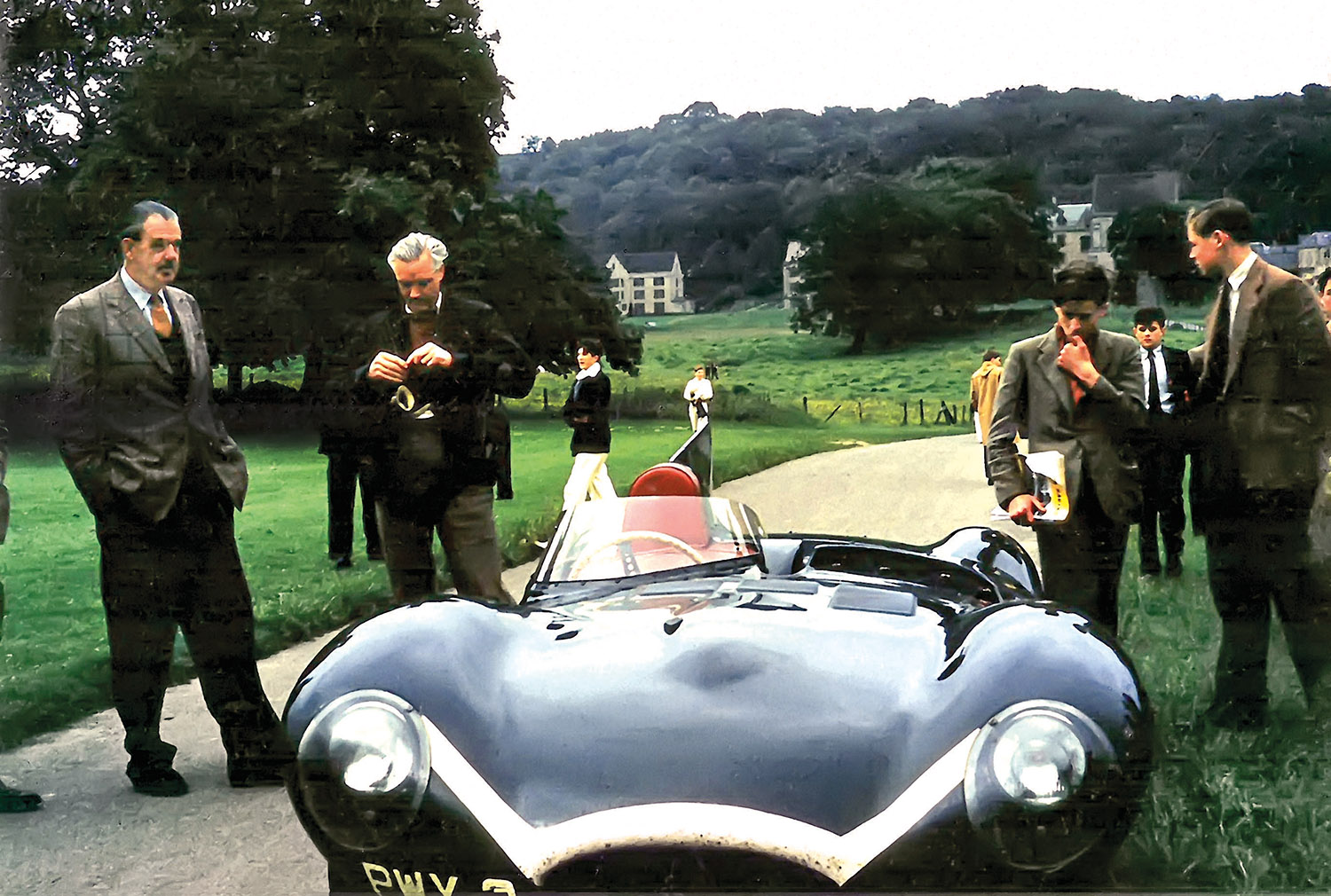
Summer of 1956, my father, left, and Jack Leith introduced me to high speed motoring when they turned up at Ampleforth College in the ex-Ecurie Ecosse Jaguar D-Type. My standing amongst my fellow pupils ws given an immediate boost.
My later passion for fast cars was probably ignited by the unexpected visit to Ampleforth of my father, Archie and his friends Jock Leith and Robert Ropner during the 1956 summer term. They arrived in a Jaguar D-Type, (reg no PWX 2) and an Aston Martin DB3S coupe, both pure competition sportscars. A similar Jaguar had just won the 24 hour race at Le Mans so I was the school hero for all of 48 hours. This was the first time I had ever sat in a racing car and we spent the day driving at high speeds throughout North Yorkshire.
I felt very imposing in my red tunic wearing Archie’s extra tall bearskin. My spectacles were a major problem as these had to be hidden beneath the fur.
My commissioning into the Scots Guards took place in front of my parents in July 1962 and I joined the First Battalion. Archie who joined the Scots Guards in 1922, was delighted that I had at last been commissioned, gave me a Downton-tuned Mini Cooper.
Public duties consisted of guarding the various Royal Palaces, the Tower of London and the Bank of England. The Tower of London was a fascinating place and the important Ceremony of the Keys has taken place every evening without fail for over seven hundred years. All the doors to the Tower are closed at 10.00 pm sharp as the Crown Jewels are stored there. The Chief Warder walks to the Traitors’ Gate where he meets a small detachment of Scots Guardsmen who escort him throughout the ceremony. All sentries on duty salute the ‘Queens Keys’ as they pass. When the Yeomen have locked the outer main gates and the two tower gates they return towards Traitors’ Gate where a waiting sentry shouts ‘Halt, who comes there?’ and the Chief Warder answers ‘The Keys’ to which the sentry asks ‘Whose Keys’ and the warder replies ‘Queen Elizabeth’s Keys’. The ceremony finishes then with the sentry responding ‘Pass, Queen Elizabeth’s Keys and all’s well’. Great fun, but I still had to get up in the middle of the night to inspect the guard.
For some silly reason I had now grown a rather pathetic moustache that had to be inked in as it failed to grow on one side. However, I felt very imposing in my red tunic wearing Archie’s extra tall bearskin. My spectacles were a major problem as these had to be hidden beneath the fur. On Queen’s Guard you marched from Wellington Barracks into Buckingham Palace then on to St. James Palace where you spent the night and were well catered for.
Book Specifications:
• Page Size: 230mm x 280mm
• Page Count: 448 pages
• Photographs: 550 images
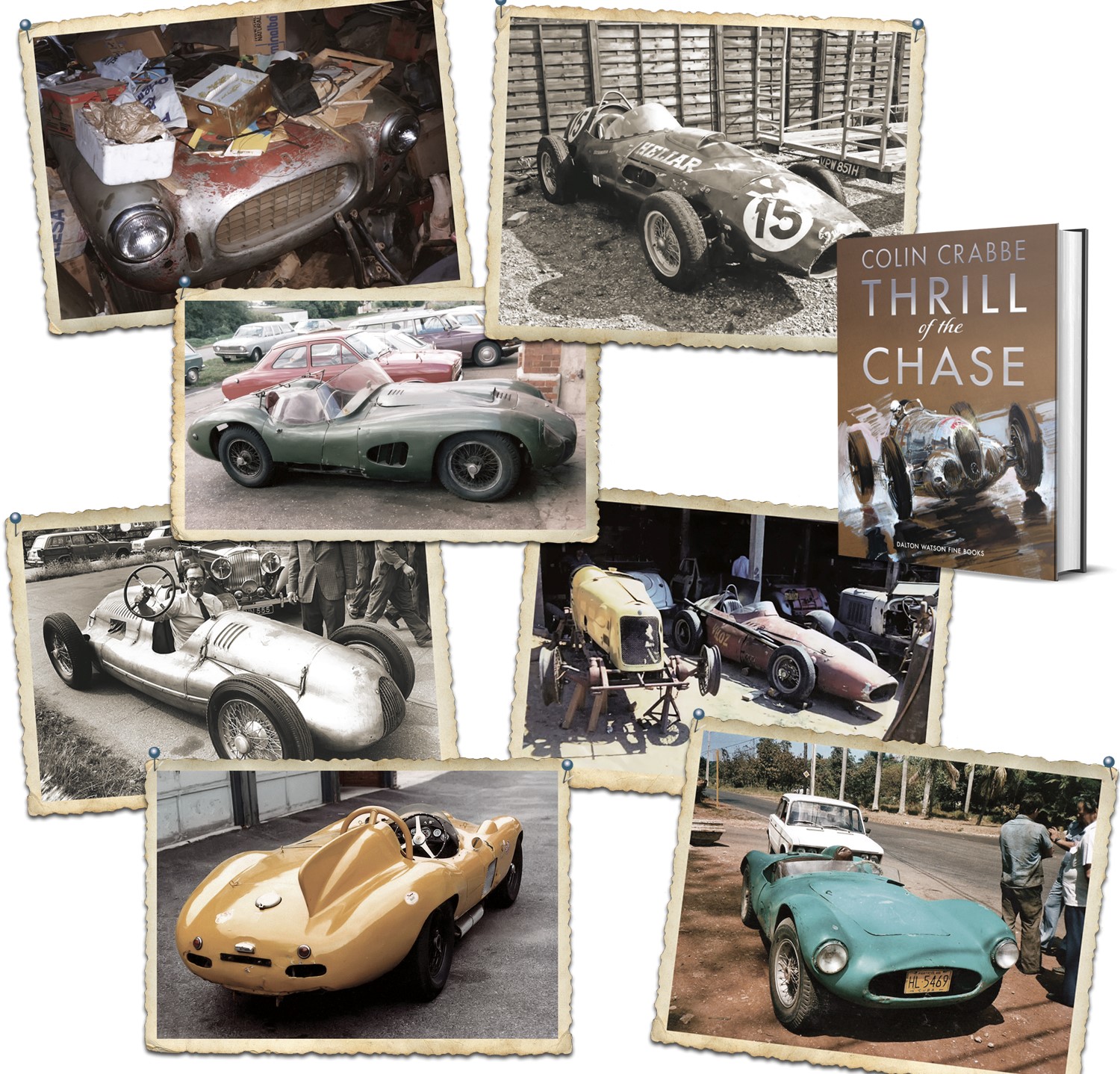
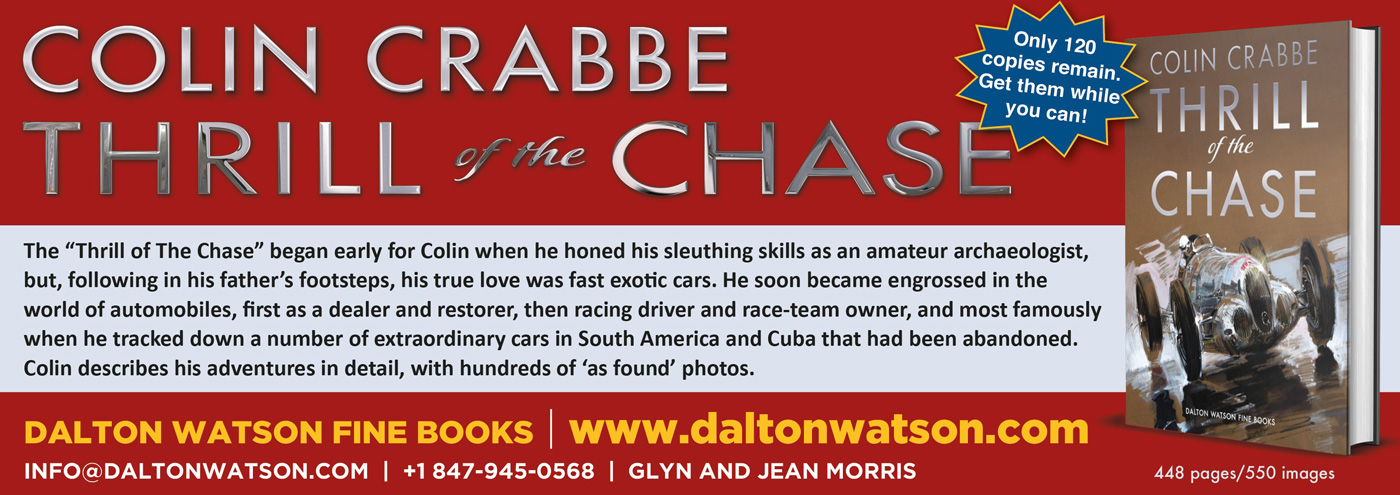

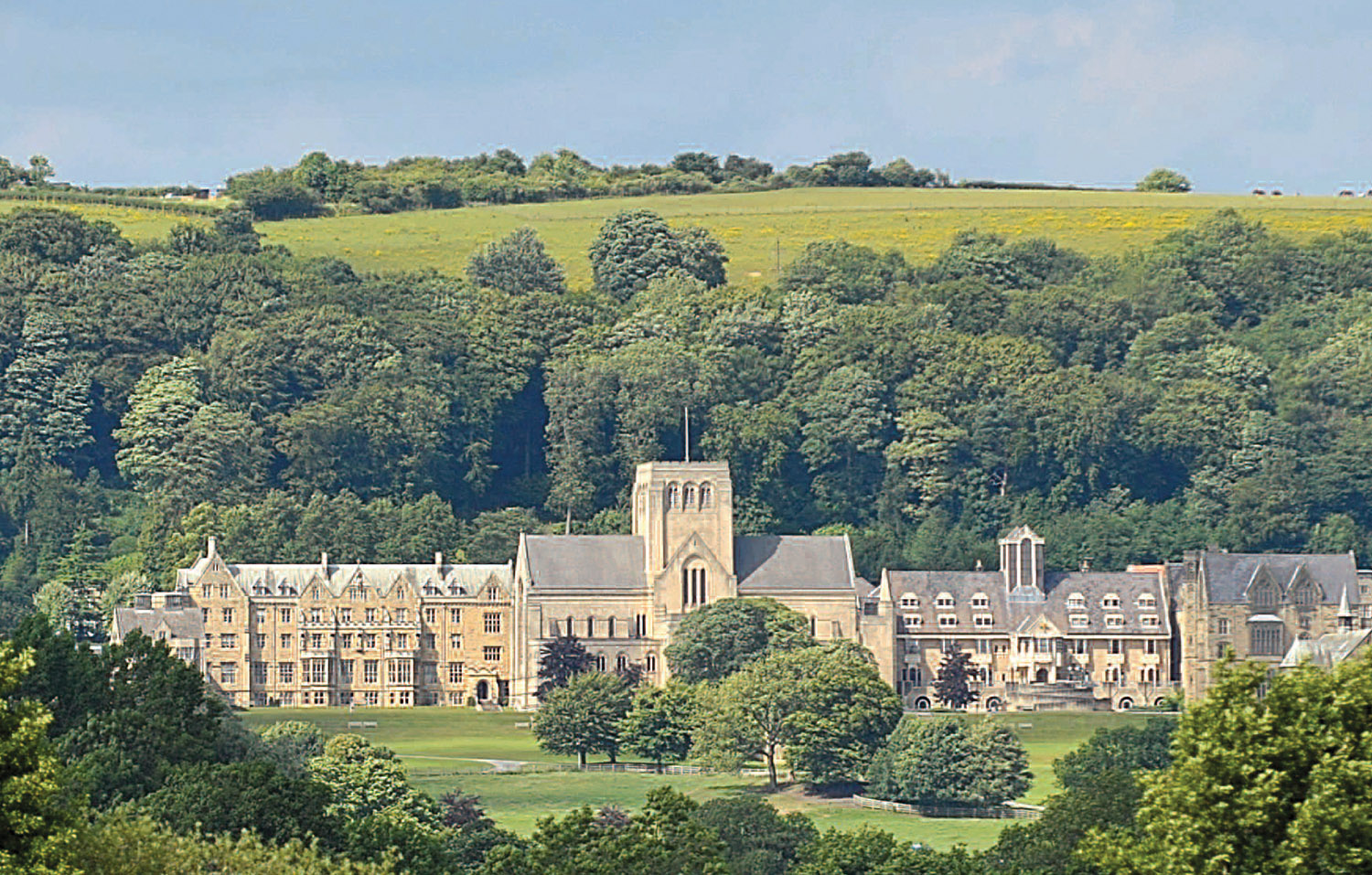
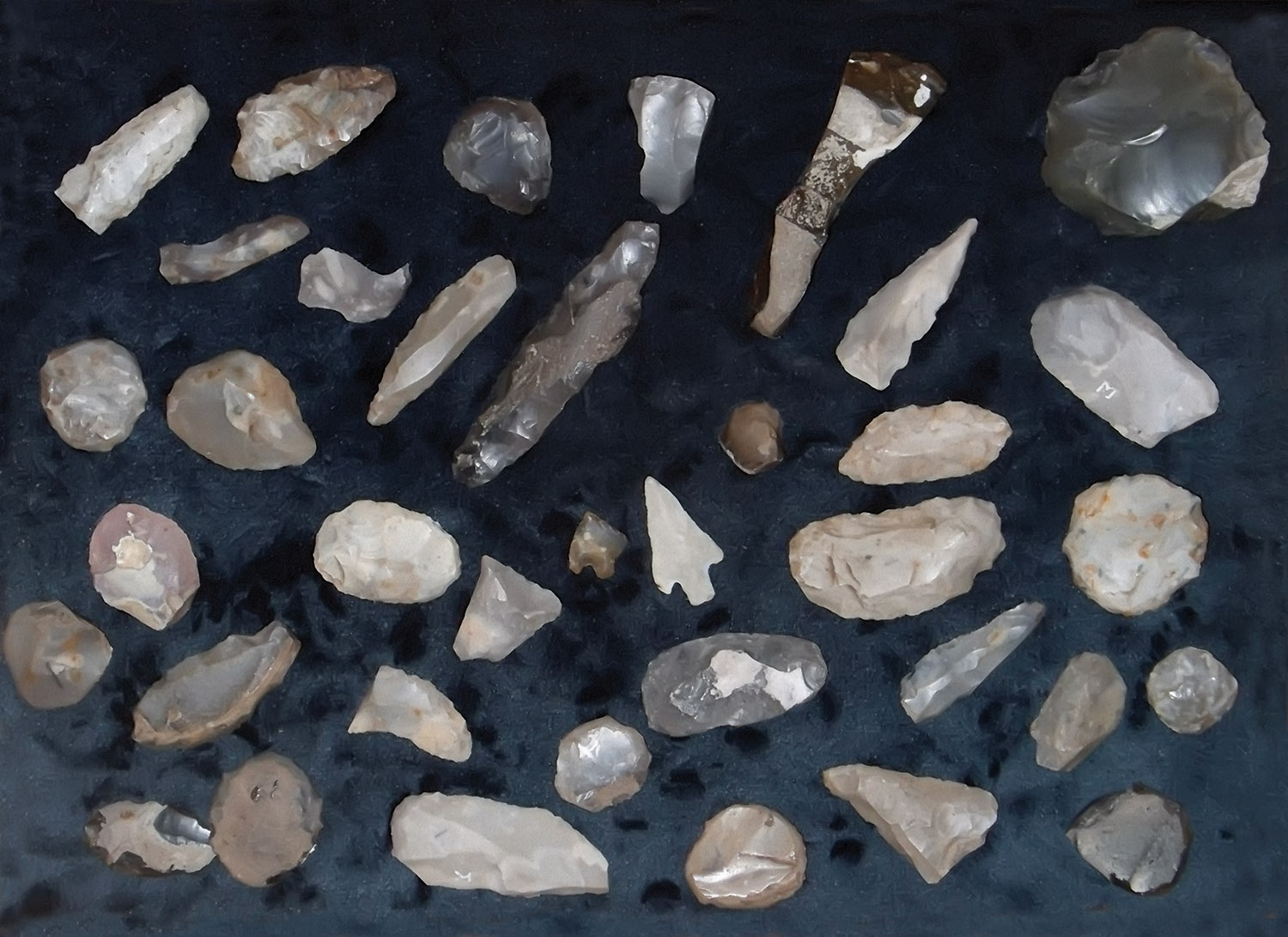
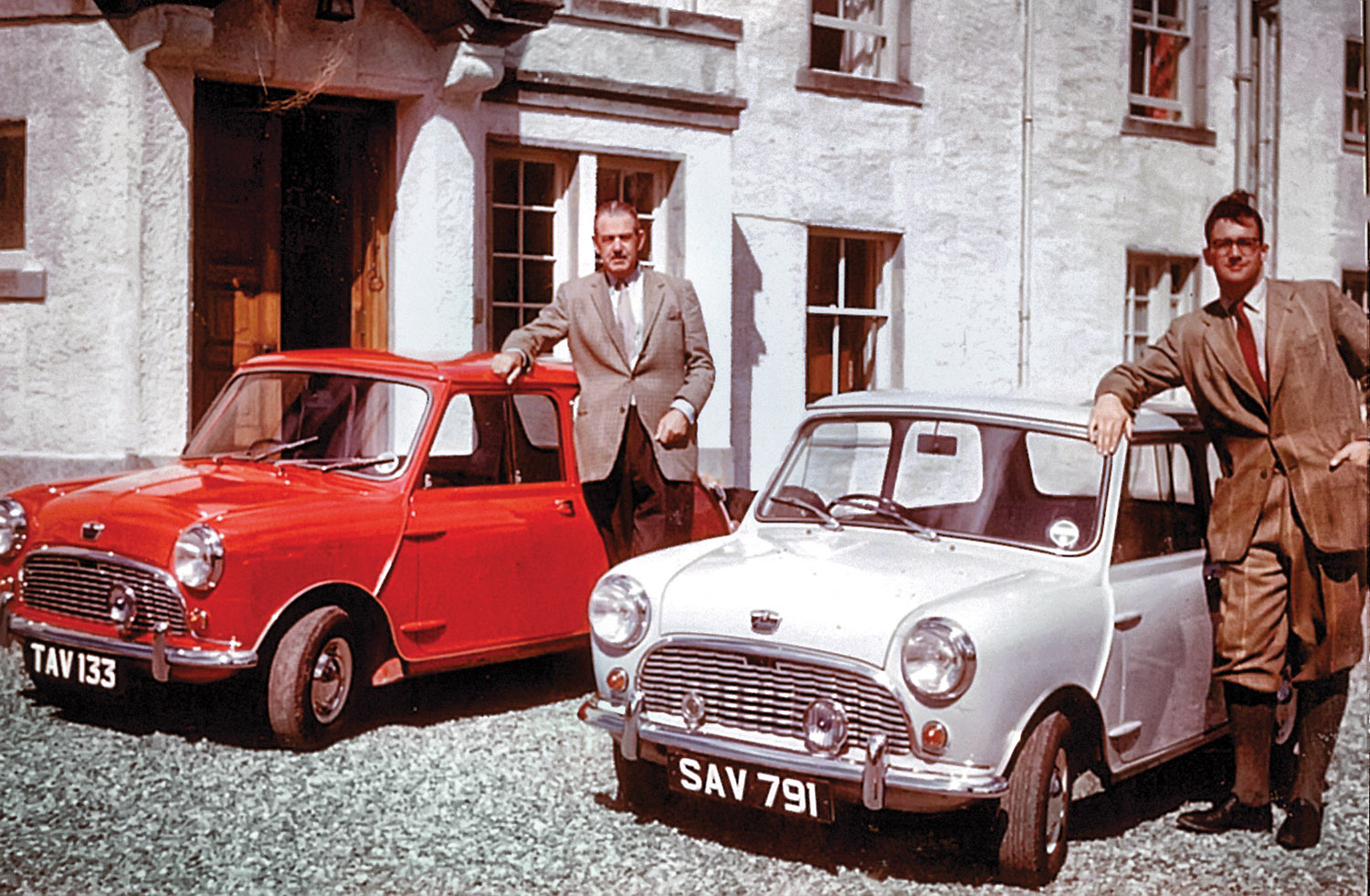
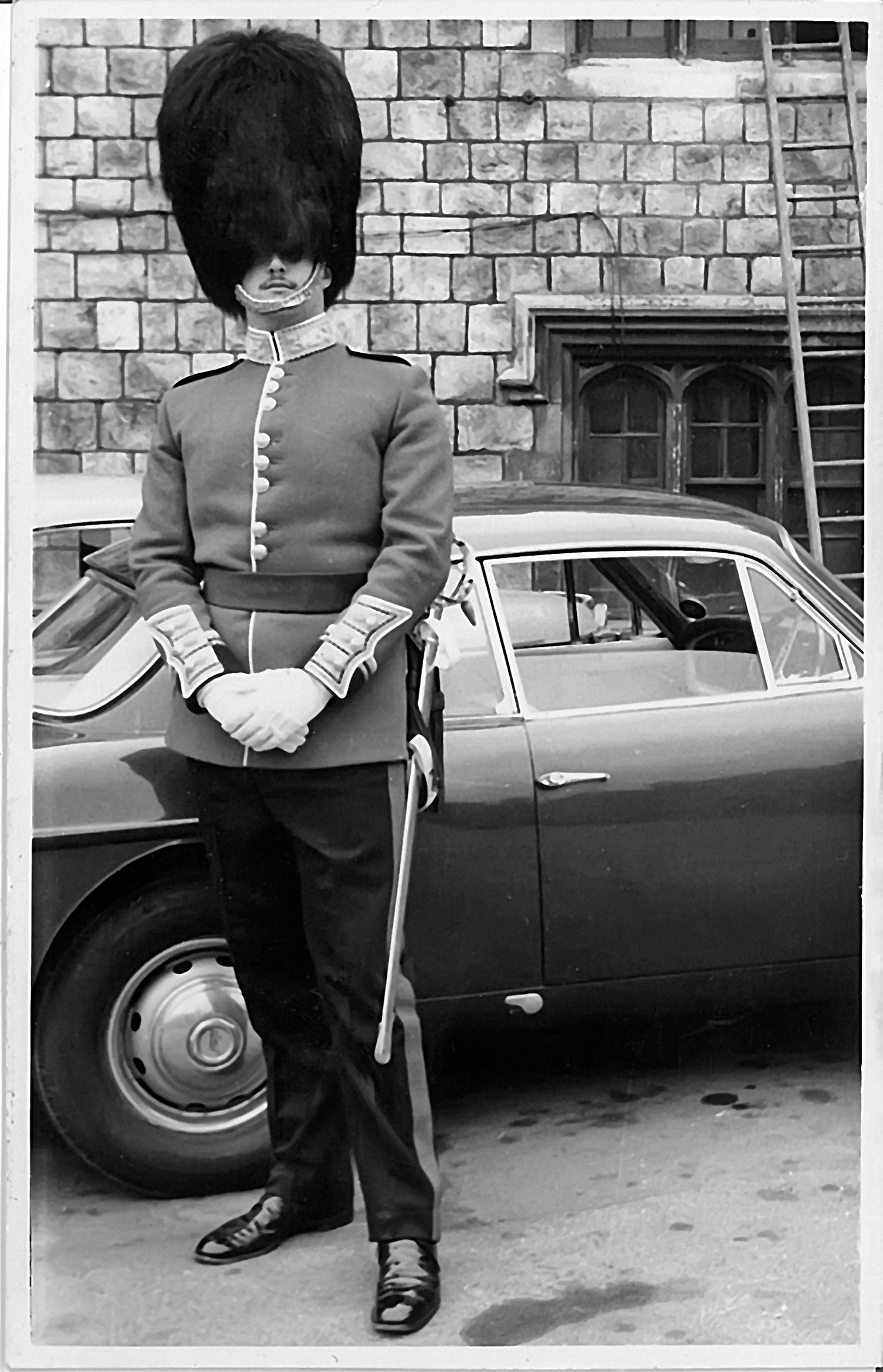
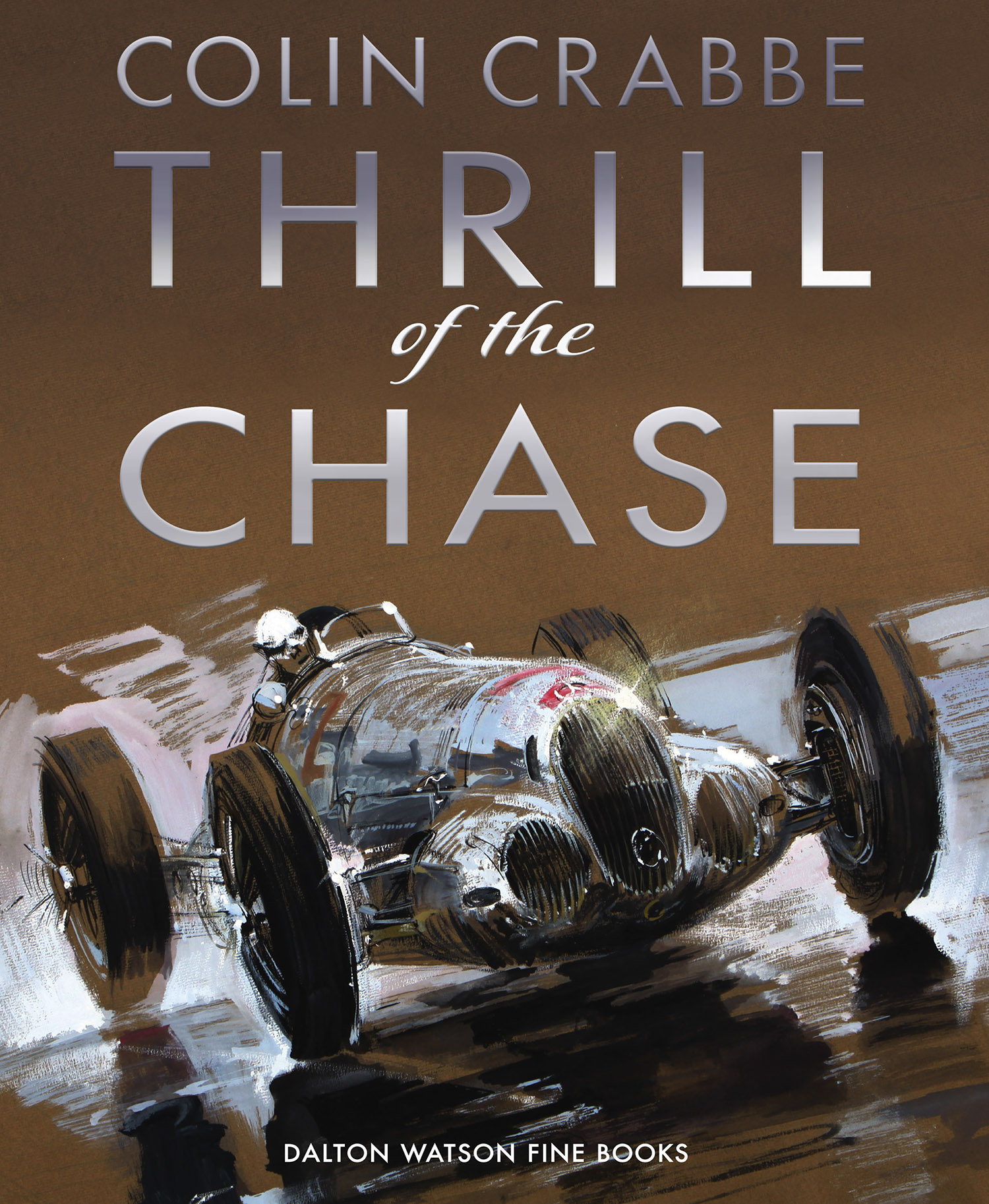
Thrill of the Chase is a fascinating book written by a larger than life character and storyteller extraordinaire. Colin Crabbe, a true enthusiast with unparalleled flair, also saved many legendary cars from potential destruction.
Good to have the book recognised on Veloce Today.
Probably my favourite book.
I just cannot wait for my copy of Colin Crabbe’s book ‘The Thrill of the Chase’, to arrive.
I had the fortune of spending a couple of weeks with Colin in Tunisia on a Rally called ‘Sables et Palmiers Rally’ between the 16th -29th April 1997 organized by Raid international of Luxembourg.
He was a larger than life character both in stature with his huge frame and personality – He had wit, charm and a great sense of humour. In our youth we had both shared a similar Roman Catholic Public School education and upbringing by Benedictine Monks at sister and rival schools – Ampleforth and Downside. I was at the latter, and being of a similar age we were at these schools at about the same time. This brought about a humour and understanding that was lost on the other rally participants, many of whom were European.
Colin was driving a pre-war BMW that he had found that had belonged to his father. I was driving my 1948 Allard M Type on its’ maiden trip testing the car out for the forthcoming 1st Peking to Paris in the coming autumn, that I had driven over across Sicily, from my native Malta nearby, using two ferries. April is the Gibli season in the Sahara. It poured with rain on the first day sending some of our cars totally unexpectedly off the hot greasy roads into the sand dunes. After a few days a ginormous sandstorm erupted – the skys turned black and the palms trees bent to an alarming angle with the forceful winds.
‘Fiona’ barked Colin to his wife, ‘Drop your tights, I need them as an additional air filter for the triple bank of Carburettors’.
Fiona, without hesitation did what she was told.
David Arrigo. Malta GC. arrigodavid@gmail.com
https://www.angleseyveterantechniques.com/